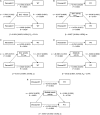The Mediating Role of Brown Fat and Skeletal Muscle Measured by 18 F-Fluorodeoxyglucose in the Thermoregulatory System in Young Adults
- PMID: 31006988
- PMCID: PMC6594074
- DOI: 10.1002/oby.22461
The Mediating Role of Brown Fat and Skeletal Muscle Measured by 18 F-Fluorodeoxyglucose in the Thermoregulatory System in Young Adults
Abstract
Objective: This study aimed to examine whether brown adipose tissue (BAT) or skeletal muscle activity mediates the relationship between personal level of environmental temperature (Personal-ET) and wrist skin temperature (WT). Moreover, we examined whether BAT and skeletal muscle have a mediating role between Personal-ET and WT (as a proxy of peripheral vasoconstriction/vasodilation).
Methods: The levels of BAT were quantified by cold-induced 18 F-fluorodeoxyglucose-positron emission tomography/computed tomography scan and measured the Personal-ET and WT by using iButtons (Maxim Integrated, Dallas, Texas) in 75 participants (74.6% women).
Results: The study found that BAT volume and metabolic activity played a positive and significant role (up to 25.4%) in the association between Personal-ET and WT. In addition, at the coldest temperatures, the participants with lower levels of WT (inducing higher peripheral vasoconstriction) had higher levels of BAT outcomes, whereas in warm temperatures, participants with higher levels of WT (inducing higher peripheral vasodilation) had lower levels of BAT outcomes. The study did not find any mediating role of skeletal muscle activity.
Conclusions: BAT volume and metabolic activity play a role in the relationship between Personal-ET and WT. Moreover, the data suggest that there are two distinct phenotypes: individuals who respond better to the cold, both through nonshivering thermogenesis and peripheral vasoconstriction, and individuals who respond better to the heat.
© 2019 The Authors. Obesity published by Wiley Periodicals, Inc. on behalf of The Obesity Society (TOS).
Figures


Similar articles
-
Association of wrist and ambient temperature with cold-induced brown adipose tissue and skeletal muscle [18F]FDG uptake in young adults.Am J Physiol Regul Integr Comp Physiol. 2018 Dec 1;315(6):R1281-R1288. doi: 10.1152/ajpregu.00238.2018. Epub 2018 Oct 26. Am J Physiol Regul Integr Comp Physiol. 2018. PMID: 30365352
-
Supraclavicular skin temperature measured by iButtons and 18F-fluorodeoxyglucose uptake by brown adipose tissue in adults.J Therm Biol. 2019 May;82:178-185. doi: 10.1016/j.jtherbio.2019.04.006. Epub 2019 Apr 16. J Therm Biol. 2019. PMID: 31128645
-
Concurrent validity of supraclavicular skin temperature measured with iButtons and infrared thermography as a surrogate marker of brown adipose tissue.J Therm Biol. 2019 May;82:186-196. doi: 10.1016/j.jtherbio.2019.04.009. Epub 2019 Apr 20. J Therm Biol. 2019. PMID: 31128647
-
Brown adipose tissue as a therapeutic target for human obesity.Obes Res Clin Pract. 2013 Dec;7(6):e432-8. doi: 10.1016/j.orcp.2013.09.001. Obes Res Clin Pract. 2013. PMID: 24459687 Review.
-
Brown adipose tissue: distribution and influencing factors on FDG PET/CT scan.J Pediatr Endocrinol Metab. 2012;25(3-4):233-7. doi: 10.1515/jpem-2012-0029. J Pediatr Endocrinol Metab. 2012. PMID: 22768649 Review.
Cited by
-
Cold-Induced Thermogenesis Shows a Diurnal Variation That Unfolds Differently in Males and Females.J Clin Endocrinol Metab. 2022 May 17;107(6):1626-1635. doi: 10.1210/clinem/dgac094. J Clin Endocrinol Metab. 2022. PMID: 35176767 Free PMC article. Clinical Trial.
References
-
- Batchelder P, Kinney RO, Demlow L, Lynch CB. Effects of temperature and social interactions on huddling behavior in Mus musculus . Physiol Behav 1983;31:97‐102. - PubMed
-
- Satinoff E. Neural organization and evolution of thermal regulation in mammals. Science 1978;201:16‐22. - PubMed
-
- McAllen RM, Tanaka M, Ootsuka Y, McKinley MJ. Multiple thermoregulatory effectors with independent central controls. Eur J Appl Physiol 2010;109:27‐33. - PubMed

